Human Resource Management in the Hospitality Industry, 9th Edition
VerifiedAdded on 2021/06/30
|14
|4176
|51
Report
AI Summary
This document is a comprehensive report on Human Resource Management in the Hospitality Industry, now in its ninth edition. It provides an in-depth understanding of the purpose, policies, and processes involved in managing a hospitality enterprise's workforce. The report is extensively updated to reflect recent trends, including labor markets, IT impacts, international brand growth, employer branding, talent management, and diversity. It explores key HRM issues with real-life applications and includes an extended case study. The report covers various aspects of HRM, such as job design, recruitment, selection, performance management, training, reward systems, employee relations, and employment law, making it a valuable resource for students and professionals in the hospitality sector. The report is enriched with international examples, figures, and case studies.
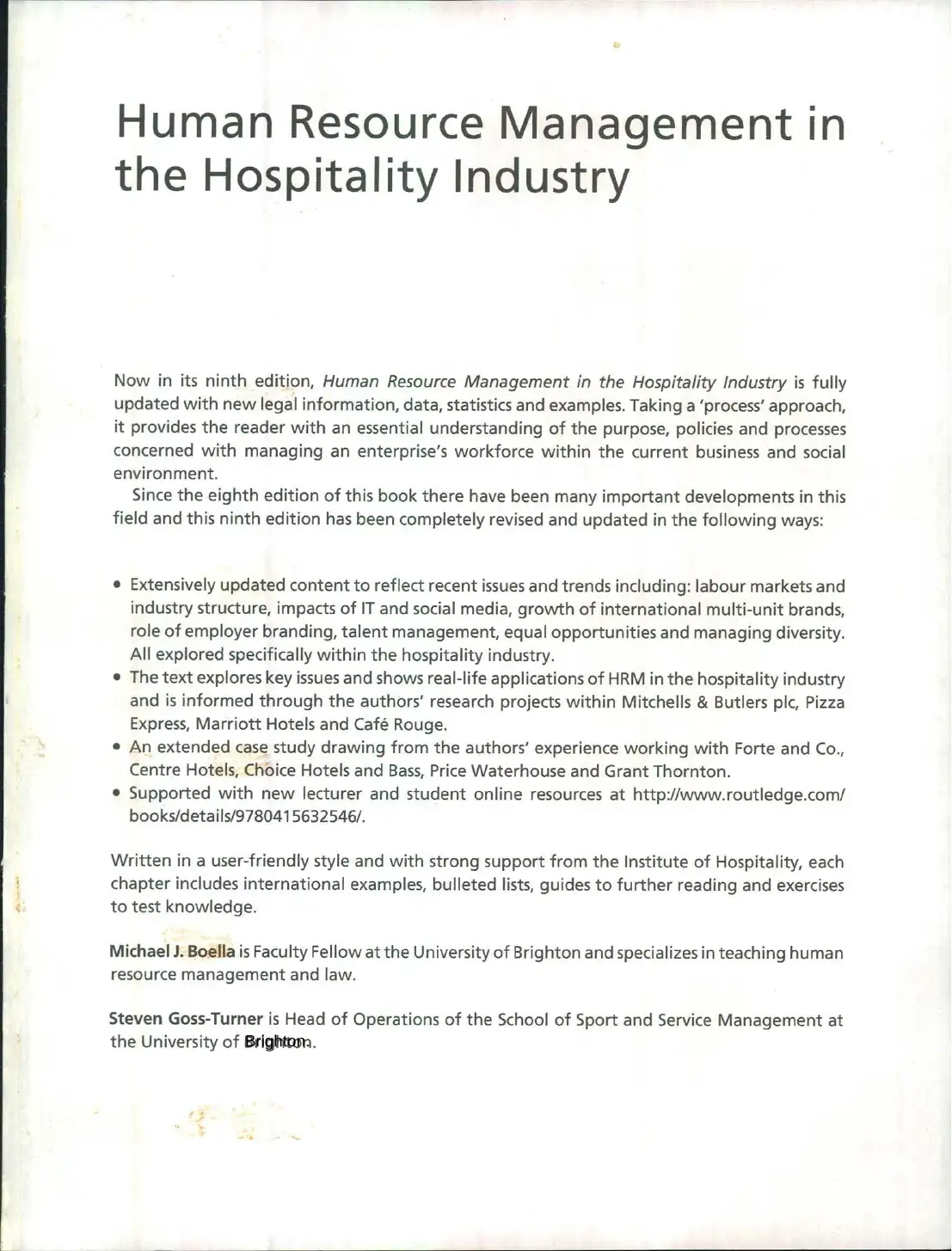
Human Resource Management in
the Hospita Iity Industry
Now in its ninth edition, Human Resource Management in the Hospitality Industry is fully
updated with new legal information, data, statistics and examples. Taking a 'process' approach,
it provides the reader with an essential understanding of the purpose, policies and processes
concerned with managing an enterprise's workforce within the current business and social
environment.
Since the eighth edition of this book there have been many important developments in this
field and this ninth edition has been completely revised and updated in the following ways:
• Extensively updated content to reflect recent issuesand trends including: labour markets and
industry structure, impacts of IT and social media, growth of international multi-unit brands,
role of employer branding, talent management, equal opportunities and managing diversity.
All explored specifically within the hospitality industry.
• The text explores key issuesand shows real-life applications of HRM in the hospitality industry
and is informed through the authors' research projects within Mitchells & Butlers pic, Pizza
Express, Marriott Hotels and Cafe Rouge.
• An extended case study drawing from the authors' experience working with Forte and Co.,
Centre Hotels, Choice Hotels and Bass,Price Waterhouse and Grant Thornton.
• Supported with new lecturer and student online resources at http://www.routledge.com/
books/details/9780415632546/.
Written in a user-friendly style and with strong support from the Institute of Hospitality, each
chapter includes international examples, bulleted lists, guides to further reading and exercises
to test knowledge.
Michael J. Boella is Faculty Fellow at the University of Brighton and specializes in teaching human
resource management and law.
Steven Goss-Turner is Head of Operations of the School of Sport and Service Management at
the University of Brighton.
the Hospita Iity Industry
Now in its ninth edition, Human Resource Management in the Hospitality Industry is fully
updated with new legal information, data, statistics and examples. Taking a 'process' approach,
it provides the reader with an essential understanding of the purpose, policies and processes
concerned with managing an enterprise's workforce within the current business and social
environment.
Since the eighth edition of this book there have been many important developments in this
field and this ninth edition has been completely revised and updated in the following ways:
• Extensively updated content to reflect recent issuesand trends including: labour markets and
industry structure, impacts of IT and social media, growth of international multi-unit brands,
role of employer branding, talent management, equal opportunities and managing diversity.
All explored specifically within the hospitality industry.
• The text explores key issuesand shows real-life applications of HRM in the hospitality industry
and is informed through the authors' research projects within Mitchells & Butlers pic, Pizza
Express, Marriott Hotels and Cafe Rouge.
• An extended case study drawing from the authors' experience working with Forte and Co.,
Centre Hotels, Choice Hotels and Bass,Price Waterhouse and Grant Thornton.
• Supported with new lecturer and student online resources at http://www.routledge.com/
books/details/9780415632546/.
Written in a user-friendly style and with strong support from the Institute of Hospitality, each
chapter includes international examples, bulleted lists, guides to further reading and exercises
to test knowledge.
Michael J. Boella is Faculty Fellow at the University of Brighton and specializes in teaching human
resource management and law.
Steven Goss-Turner is Head of Operations of the School of Sport and Service Management at
the University of Brighton.
Paraphrase This Document
Need a fresh take? Get an instant paraphrase of this document with our AI Paraphraser
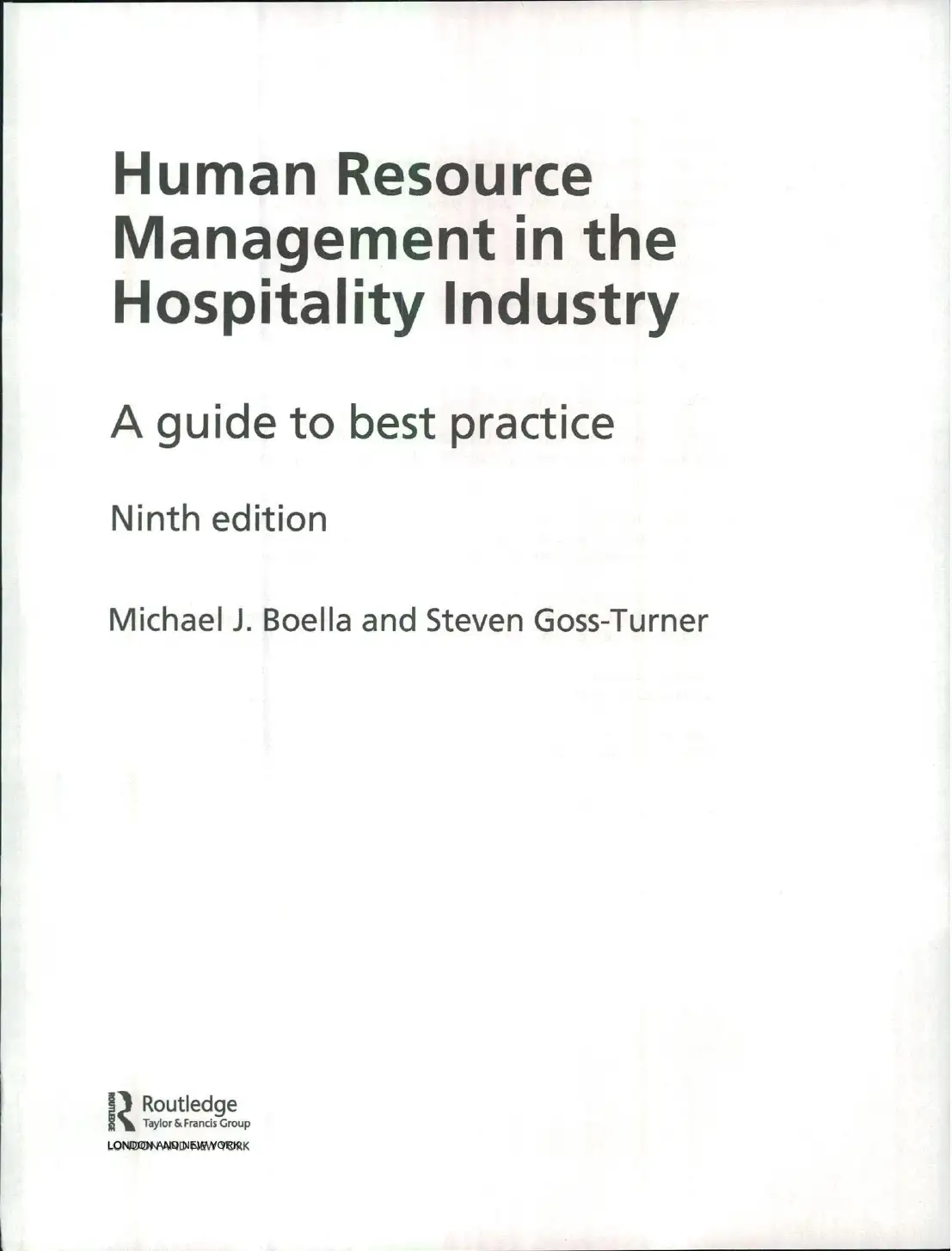
Human Resource
Management in the
Hospitality Industry
A guide to best practice
Ninth edition
Michael J. Boella and Steven Goss-Turner
i~~~o~;!~n~~:up
LONDON AND NEW YORK
Management in the
Hospitality Industry
A guide to best practice
Ninth edition
Michael J. Boella and Steven Goss-Turner
i~~~o~;!~n~~:up
LONDON AND NEW YORK
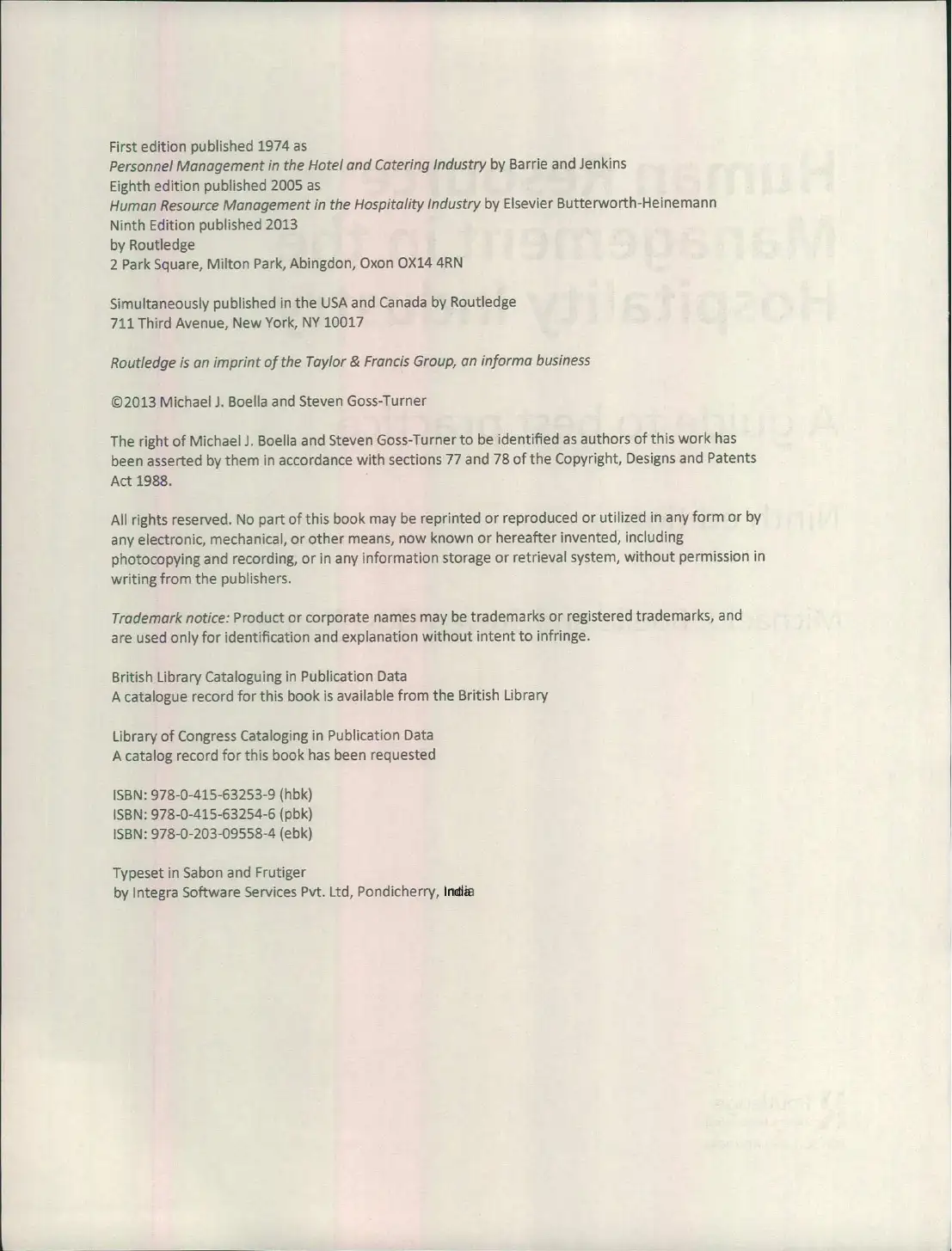
First edition published 1974 as
Personnel Management in the Hotel and Catering Industry by Barrie and Jenkins
Eighth edition published 2005 as
Human Resource Management in the Hospitality Industry by Elsevier Butterworth-Heinemann
Ninth Edition published 2013
by Routledge
2 Park Square, Milton Park, Abingdon, Oxon OX14 4RN
Simultaneously published in the USA and Canada by Routledge
711 Third Avenue, New York, NY 10017
Routledge is an imprint of the Taylor & Francis Group, an informa business
@2013 Michael J. Boella and Steven Goss-Turner
The right of Michael J. Boella and Steven Goss-Turner to be identified as authors of this work has
been asserted by them in accordance with sections 77 and 78 of the Copyright, Designs and Patents
Act 1988.
All rights reserved. No part of this book may be reprinted or reproduced or utilized in any form or by
any electronic, mechanical, or other means, now known or hereafter invented, including
photocopying and recording, or in any information storage or retrieval system, without permission in
writing from the publishers.
Trodemark notice: Product or corporate names may be trademarks or registered trademarks, and
are used only for identification and explanation without intent to infringe.
British Library Cataloguing in Publication Data
A catalogue record for this book is available from the British Library
Library of Congress Cataloging in Publication Data
A catalog record for this book has been requested
ISBN: 978-0-415-63253-9 (hbk)
ISBN: 978-0-415-63254-6 (pbk)
15BN: 978-0-203-09558-4 (ebk)
Typeset in 5abon and Frutiger
by Integra Software Services Pvt. Ltd, Pondicherry, India
Personnel Management in the Hotel and Catering Industry by Barrie and Jenkins
Eighth edition published 2005 as
Human Resource Management in the Hospitality Industry by Elsevier Butterworth-Heinemann
Ninth Edition published 2013
by Routledge
2 Park Square, Milton Park, Abingdon, Oxon OX14 4RN
Simultaneously published in the USA and Canada by Routledge
711 Third Avenue, New York, NY 10017
Routledge is an imprint of the Taylor & Francis Group, an informa business
@2013 Michael J. Boella and Steven Goss-Turner
The right of Michael J. Boella and Steven Goss-Turner to be identified as authors of this work has
been asserted by them in accordance with sections 77 and 78 of the Copyright, Designs and Patents
Act 1988.
All rights reserved. No part of this book may be reprinted or reproduced or utilized in any form or by
any electronic, mechanical, or other means, now known or hereafter invented, including
photocopying and recording, or in any information storage or retrieval system, without permission in
writing from the publishers.
Trodemark notice: Product or corporate names may be trademarks or registered trademarks, and
are used only for identification and explanation without intent to infringe.
British Library Cataloguing in Publication Data
A catalogue record for this book is available from the British Library
Library of Congress Cataloging in Publication Data
A catalog record for this book has been requested
ISBN: 978-0-415-63253-9 (hbk)
ISBN: 978-0-415-63254-6 (pbk)
15BN: 978-0-203-09558-4 (ebk)
Typeset in 5abon and Frutiger
by Integra Software Services Pvt. Ltd, Pondicherry, India
⊘ This is a preview!⊘
Do you want full access?
Subscribe today to unlock all pages.

Trusted by 1+ million students worldwide
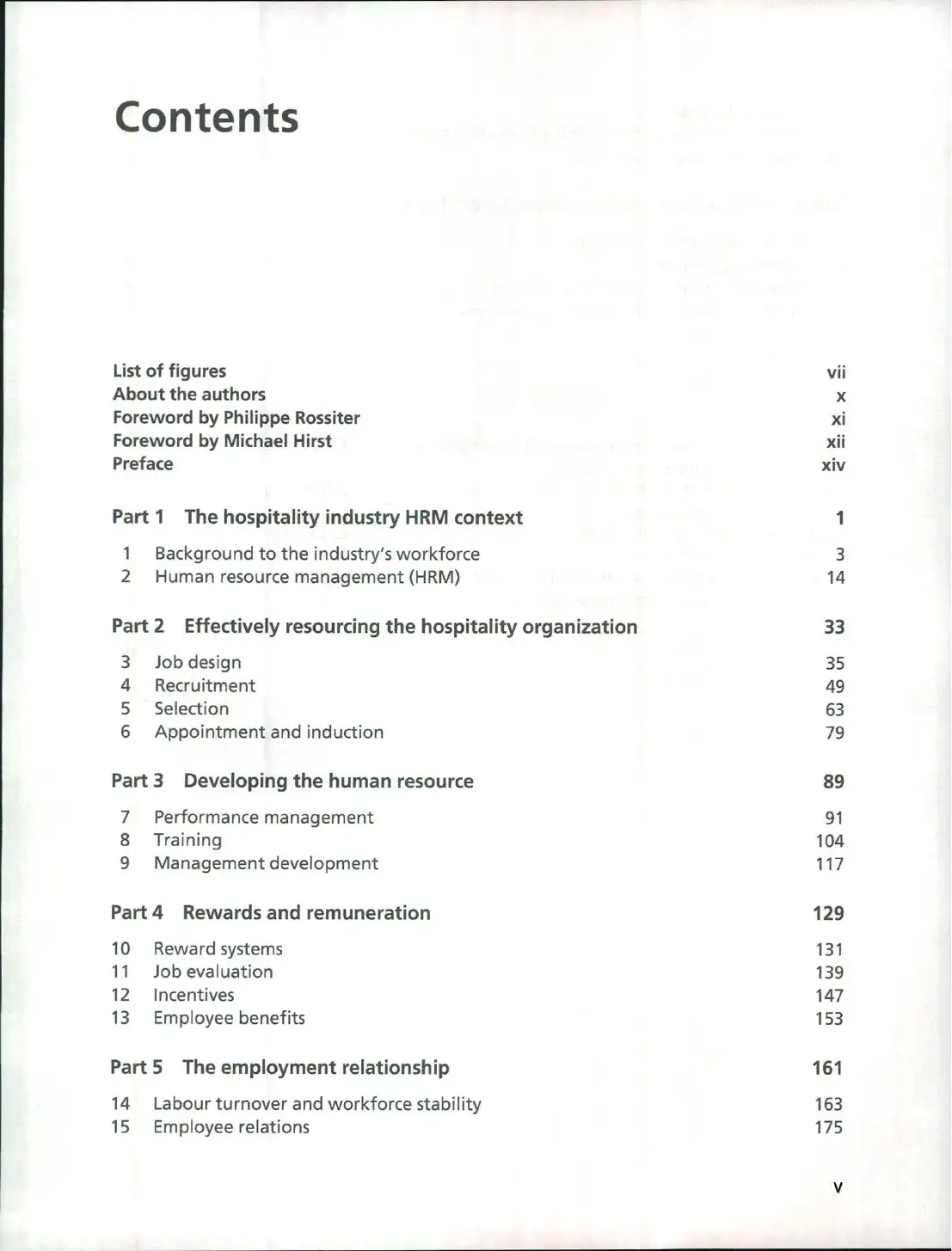
Contents
List of figures
About the authors
Foreword by Philippe Rossiter
Foreword by Michael Hirst
Preface
Part 1 The hospitality industry HRM context
1 Background to the industry's workforce
2 Human resource management (HRM)
Part 2 Effectively resourcing the hospitality organization
3 Job design
4 Recruitment
5 Selection
6 Appointment and induction
Part 3 Developing the human resource
7 Performance management
8 Training
9 Management development
Part 4 Rewards and remuneration
10 Reward systems
11 Job evaluation
12 Incentives
13 Employee benefits
Part 5 The employment relationship
14 Labour turnover and workforce stability
15 Employee relations
vii
x
xi
xii
xiv
1
3
14
33
35
49
63
79
89
91
104
117
129
131
139
147
153
161
163
175
v
List of figures
About the authors
Foreword by Philippe Rossiter
Foreword by Michael Hirst
Preface
Part 1 The hospitality industry HRM context
1 Background to the industry's workforce
2 Human resource management (HRM)
Part 2 Effectively resourcing the hospitality organization
3 Job design
4 Recruitment
5 Selection
6 Appointment and induction
Part 3 Developing the human resource
7 Performance management
8 Training
9 Management development
Part 4 Rewards and remuneration
10 Reward systems
11 Job evaluation
12 Incentives
13 Employee benefits
Part 5 The employment relationship
14 Labour turnover and workforce stability
15 Employee relations
vii
x
xi
xii
xiv
1
3
14
33
35
49
63
79
89
91
104
117
129
131
139
147
153
161
163
175
v
Paraphrase This Document
Need a fresh take? Get an instant paraphrase of this document with our AI Paraphraser
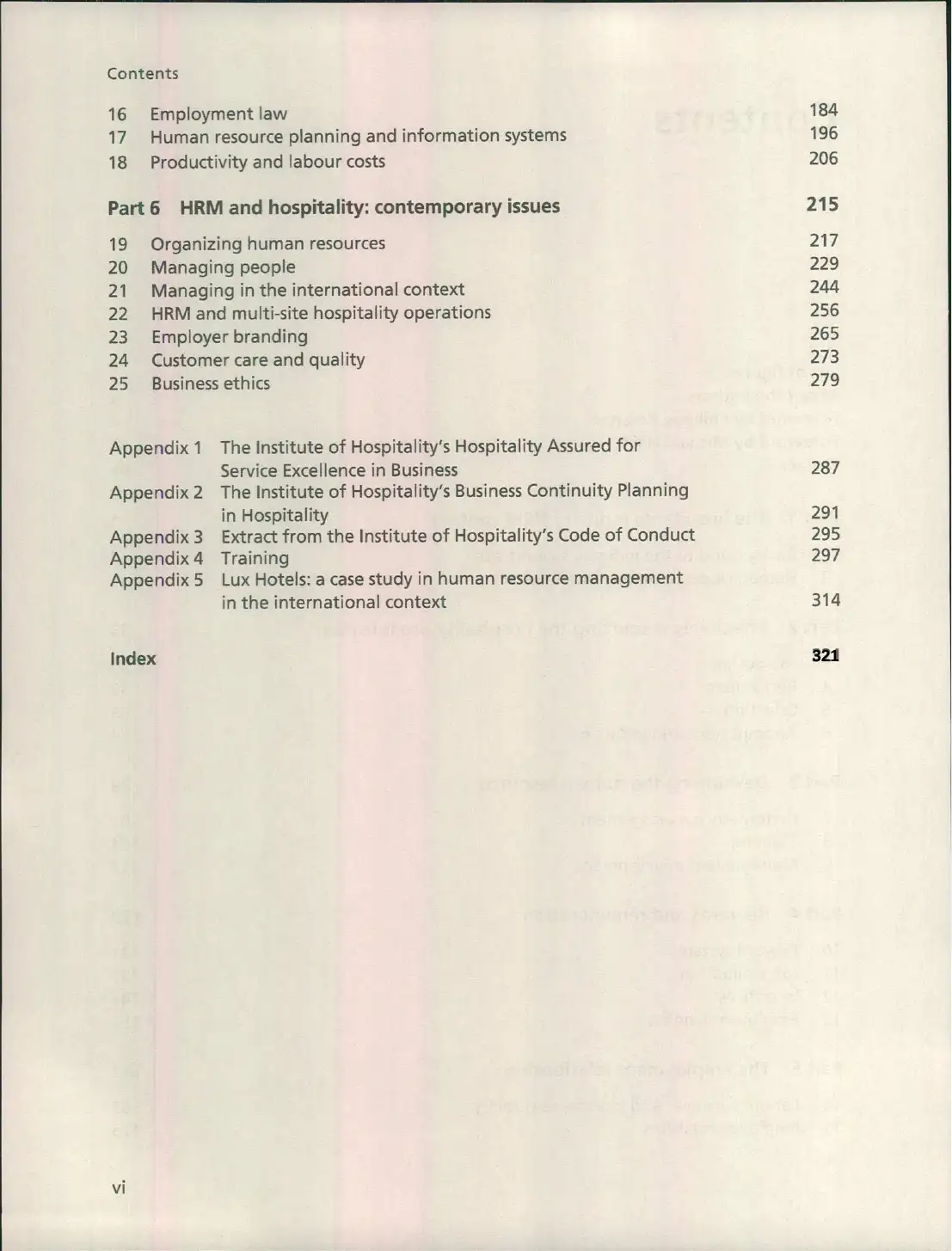
Contents
16 Employment law
17 Human resource planning and information systems
18 Productivity and labour costs
Part 6 HRM and hospitality: contemporary issues
19 Organizing human resources
20 Managing people
21 Managing in the international context
22 HRM and multi-site hospitality operations
23 Employer branding
24 Customer care and quality
25 Business ethics
Appendix 1 The Institute of Hospitality's Hospitality Assured for
Service Excellence in Business
Appendix 2 The Institute of Hospitality's Business Continuity Planning
in Hospitality
Appendix 3 Extract from the Institute of Hospitality's Code of Conduct
Appendix 4 Training
Appendix 5 Lux Hotels: a case study in human resource management
in the international context
Index
vi
184
196
206
215
217
229
244
256
265
273
279
287
291
295
297
314
321
16 Employment law
17 Human resource planning and information systems
18 Productivity and labour costs
Part 6 HRM and hospitality: contemporary issues
19 Organizing human resources
20 Managing people
21 Managing in the international context
22 HRM and multi-site hospitality operations
23 Employer branding
24 Customer care and quality
25 Business ethics
Appendix 1 The Institute of Hospitality's Hospitality Assured for
Service Excellence in Business
Appendix 2 The Institute of Hospitality's Business Continuity Planning
in Hospitality
Appendix 3 Extract from the Institute of Hospitality's Code of Conduct
Appendix 4 Training
Appendix 5 Lux Hotels: a case study in human resource management
in the international context
Index
vi
184
196
206
215
217
229
244
256
265
273
279
287
291
295
297
314
321
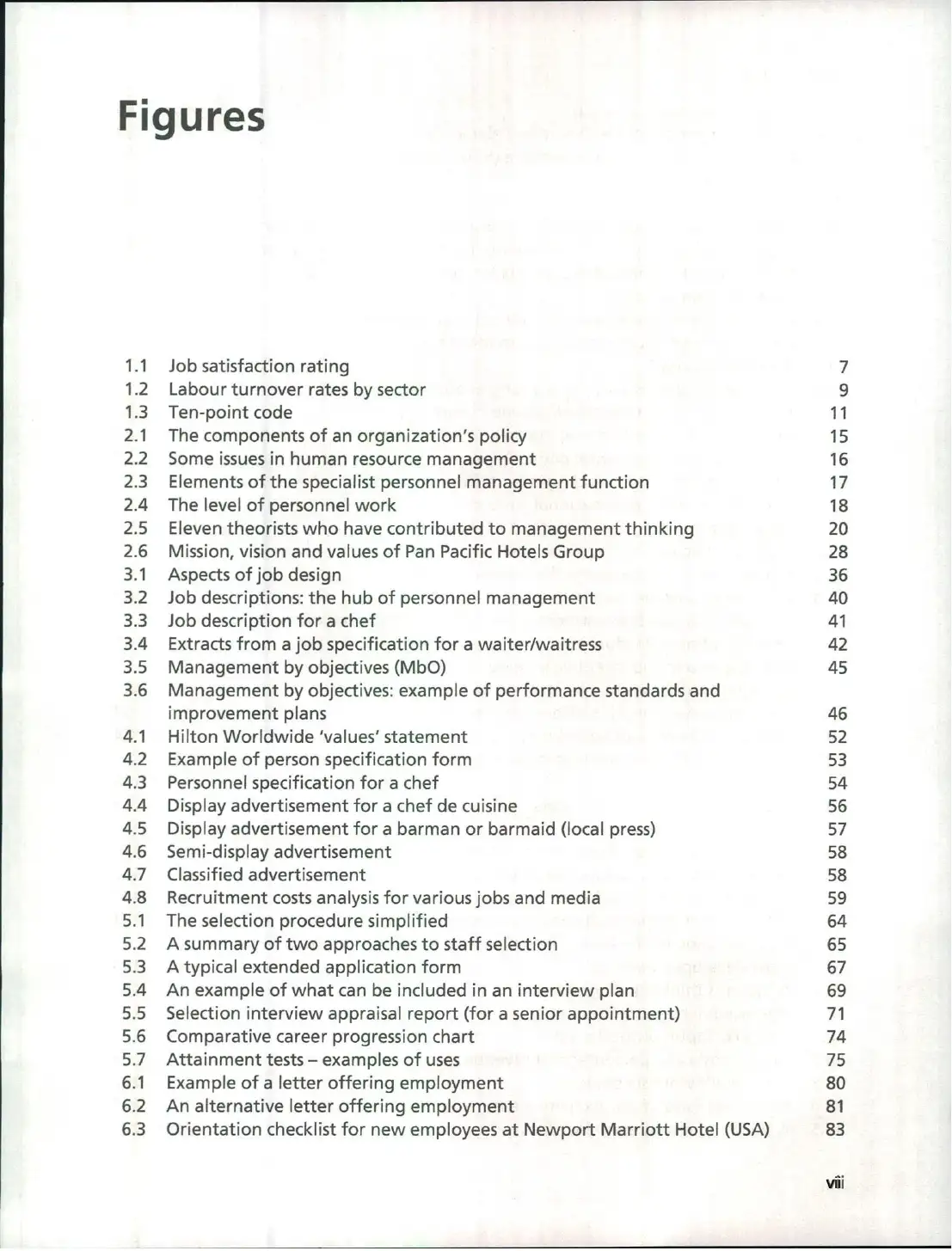
Figures
1.1 Job satisfaction rating 7
1.2 Labour turnover rates by sector 9
1.3 Ten-point code 11
2.1 The components of an organization's policy 15
2.2 Some issuesin human resource management 16
2.3 Elements of the specialist personnel management function 17
2.4 The level of personnel work 18
2.5 Eleven theorists who have contributed to management thinking 20
2.6 Mission, vision and values of Pan Pacific Hotels Group 28
3.1 Aspects of job design 36
3.2 Job descriptions: the hub of personnel management 40
3.3 Job description for a chef 41
3.4 Extracts from a job specification for a waiter/waitress 42
3.5 Management by objectives (Mba) 45
3.6 Management by objectives: example of performance standards and
improvement plans 46
4.1 Hilton Worldwide 'values' statement 52
4.2 Example of person specification form 53
4.3 Personnel specification for a chef 54
4.4 Display advertisement for a chef de cuisine 56
4.5 Display advertisement for a barman or barmaid (local press) 57
4.6 Semi-display advertisement 58
4.7 Classified advertisement 58
4.8 Recruitment costs analysis for various jobs and media 59
5.1 The selection procedure simplified 64
5.2 A summary of two approaches to staff selection 65
5.3 A typical extended application form 67
5.4 An example of what can be included in an interview plan 69
5.5 Selection interview appraisal report (for a senior appointment) 71
5.6 Comparative career progression chart 74
5.7 Attainment tests - examples of uses 75
6.1 Example of a letter offering employment 80
6.2 An alternative letter offering employment 81
6.3 Orientation checklist for new employees at Newport Marriott Hotel (USA) 83
vii
1.1 Job satisfaction rating 7
1.2 Labour turnover rates by sector 9
1.3 Ten-point code 11
2.1 The components of an organization's policy 15
2.2 Some issuesin human resource management 16
2.3 Elements of the specialist personnel management function 17
2.4 The level of personnel work 18
2.5 Eleven theorists who have contributed to management thinking 20
2.6 Mission, vision and values of Pan Pacific Hotels Group 28
3.1 Aspects of job design 36
3.2 Job descriptions: the hub of personnel management 40
3.3 Job description for a chef 41
3.4 Extracts from a job specification for a waiter/waitress 42
3.5 Management by objectives (Mba) 45
3.6 Management by objectives: example of performance standards and
improvement plans 46
4.1 Hilton Worldwide 'values' statement 52
4.2 Example of person specification form 53
4.3 Personnel specification for a chef 54
4.4 Display advertisement for a chef de cuisine 56
4.5 Display advertisement for a barman or barmaid (local press) 57
4.6 Semi-display advertisement 58
4.7 Classified advertisement 58
4.8 Recruitment costs analysis for various jobs and media 59
5.1 The selection procedure simplified 64
5.2 A summary of two approaches to staff selection 65
5.3 A typical extended application form 67
5.4 An example of what can be included in an interview plan 69
5.5 Selection interview appraisal report (for a senior appointment) 71
5.6 Comparative career progression chart 74
5.7 Attainment tests - examples of uses 75
6.1 Example of a letter offering employment 80
6.2 An alternative letter offering employment 81
6.3 Orientation checklist for new employees at Newport Marriott Hotel (USA) 83
vii
⊘ This is a preview!⊘
Do you want full access?
Subscribe today to unlock all pages.

Trusted by 1+ million students worldwide
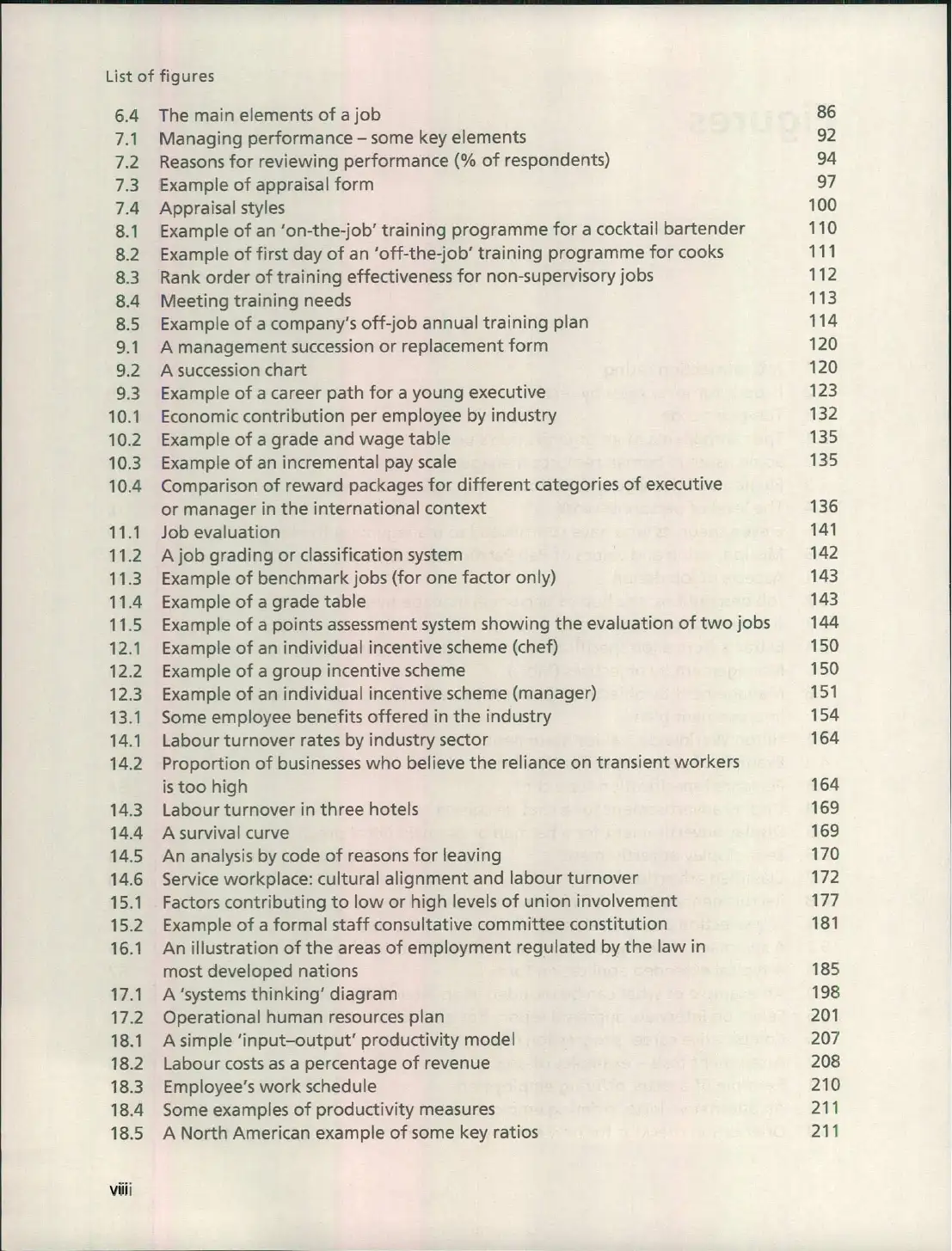
List of figures
6.4 The main elements of a job 86
7.1 Managing performance - some key elements 92
7.2 Reasonsfor reviewing performance (% of respondents) 94
7.3 Example of appraisal form 97
7.4 Appraisal styles 100
8.1 Example of an 'on-the-job' training programme for a cocktail bartender 110
8.2 Example of first day of an 'off-the-job' training programme for cooks 111
8.3 Rank order of training effectiveness for non-supervisory jobs 112
8.4 Meeting training needs 113
8.5 Example of a company's off-job annual training plan 114
9.1 A management successionor replacement form 120
9.2 A successionchart 120
9.3 Example of a career path for a young executive 123
10.1 Economic contribution per employee by industry 132
10.2 Example of a grade and wage table 135
10.3 Example of an incremental pay scale 135
10.4 Comparison of reward packages for different categories of executive
or manager in the international context 136
11.1 Job evaluation 141
11.2 A job grading or classification system 142
11.3 Example of benchmark jobs (for one factor only) 143
11.4 Example of a grade table 143
11.5 Example of a points assessmentsystem showing the evaluation of two jobs 144
12.1 Example of an individual incentive scheme (chef) 150
12.2 Example of a group incentive scheme 150
12.3 Example of an individual incentive scheme (manager) 151
13.1 Some employee benefits offered in the industry 154
14.1 Labour turnover rates by industry sector 164
14.2 Proportion of businesseswho believe the reliance on transient workers
is too high 164
14.3 Labour turnover in three hotels 169
14.4 A survival curve 169
14.5 An analysis by code of reasons for leaving 170
14.6 Service workplace: cultural alignment and labour turnover 172
15.1 Factors contributing to low or high levels of union involvement 177
15.2 Example of a formal staff consultative committee constitution 181
16.1 An illustration ofthe areas of employment regulated by the law in
most developed nations 185
17.1 A 'systems thinking' diagram 198
17.2 Operational human resources plan 201
18.1 A simple 'input-output' productivity model 207
18.2 Labour costs as a percentage of revenue 208
18.3 Employee's work schedule 210
18.4 Some examples of productivity measures 211
18.5 A North American example of some key ratios 211
viii
6.4 The main elements of a job 86
7.1 Managing performance - some key elements 92
7.2 Reasonsfor reviewing performance (% of respondents) 94
7.3 Example of appraisal form 97
7.4 Appraisal styles 100
8.1 Example of an 'on-the-job' training programme for a cocktail bartender 110
8.2 Example of first day of an 'off-the-job' training programme for cooks 111
8.3 Rank order of training effectiveness for non-supervisory jobs 112
8.4 Meeting training needs 113
8.5 Example of a company's off-job annual training plan 114
9.1 A management successionor replacement form 120
9.2 A successionchart 120
9.3 Example of a career path for a young executive 123
10.1 Economic contribution per employee by industry 132
10.2 Example of a grade and wage table 135
10.3 Example of an incremental pay scale 135
10.4 Comparison of reward packages for different categories of executive
or manager in the international context 136
11.1 Job evaluation 141
11.2 A job grading or classification system 142
11.3 Example of benchmark jobs (for one factor only) 143
11.4 Example of a grade table 143
11.5 Example of a points assessmentsystem showing the evaluation of two jobs 144
12.1 Example of an individual incentive scheme (chef) 150
12.2 Example of a group incentive scheme 150
12.3 Example of an individual incentive scheme (manager) 151
13.1 Some employee benefits offered in the industry 154
14.1 Labour turnover rates by industry sector 164
14.2 Proportion of businesseswho believe the reliance on transient workers
is too high 164
14.3 Labour turnover in three hotels 169
14.4 A survival curve 169
14.5 An analysis by code of reasons for leaving 170
14.6 Service workplace: cultural alignment and labour turnover 172
15.1 Factors contributing to low or high levels of union involvement 177
15.2 Example of a formal staff consultative committee constitution 181
16.1 An illustration ofthe areas of employment regulated by the law in
most developed nations 185
17.1 A 'systems thinking' diagram 198
17.2 Operational human resources plan 201
18.1 A simple 'input-output' productivity model 207
18.2 Labour costs as a percentage of revenue 208
18.3 Employee's work schedule 210
18.4 Some examples of productivity measures 211
18.5 A North American example of some key ratios 211
viii
Paraphrase This Document
Need a fresh take? Get an instant paraphrase of this document with our AI Paraphraser
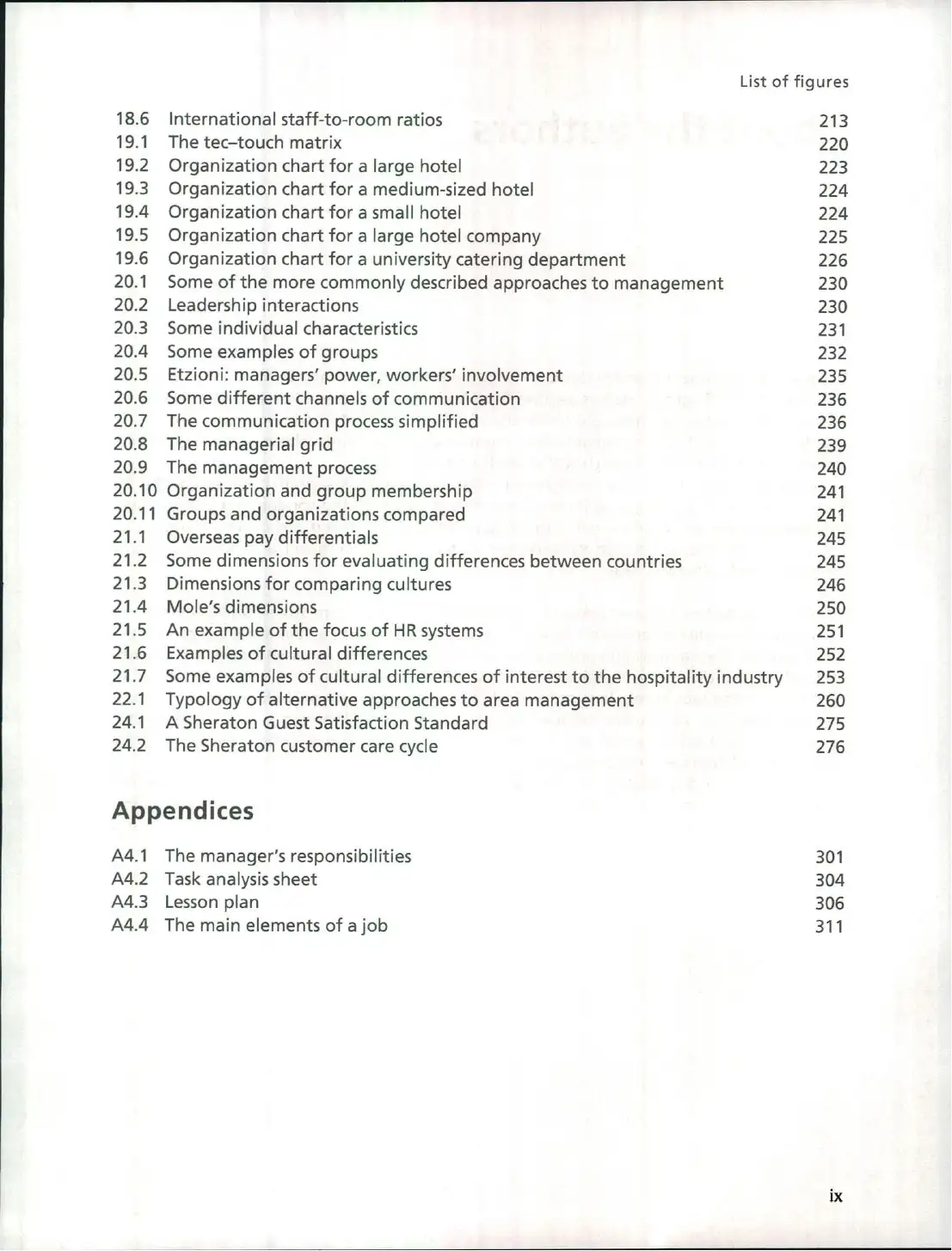
List of figures
18.6 International staff-to-room ratios 213
19.1 The tee-touch matrix 220
19.2 Organization chart for a large hotel 223
19.3 Organization chart for a medium-sized hotel 224
19.4 Organization chart for a small hotel 224
19.5 Organization chart for a large hotel company 225
19.6 Organization chart for a university catering department 226
20.1 Some of the more commonly described approaches to management 230
20.2 Leadership interactions 230
20.3 Some individual characteristics 231
20.4 Some examples of groups 232
20.5 Etzioni: managers' power, workers' involvement 235
20.6 Some different channels of communication 236
20.7 The communication process simplified 236
20.8 The managerial grid 239
20.9 The management process 240
20.10 Organization and group membership 241
20.11 Groups and organizations compared 241
21.1 Overseas pay differentials 245
21.2 Some dimensions for evaluating differences between countries 245
21.3 Dimensions for comparing cultures 246
21.4 Mole's dimensions 250
21.5 An example of the focus of HR systems 251
21.6 Examples of cultural differences 252
21.7 Some examples of cultural differences of interest to the hospitality industry 253
22.1 Typology of alternative approaches to area management 260
24.1 A Sheraton Guest Satisfaction Standard 275
24.2 The Sheraton customer care cycle 276
Appendices
A4.1 The manager's responsibilities
A4.2 Task analysis sheet
A4.3 Lesson plan
A4.4 The main elements of a job
301
304
306
311
ix
18.6 International staff-to-room ratios 213
19.1 The tee-touch matrix 220
19.2 Organization chart for a large hotel 223
19.3 Organization chart for a medium-sized hotel 224
19.4 Organization chart for a small hotel 224
19.5 Organization chart for a large hotel company 225
19.6 Organization chart for a university catering department 226
20.1 Some of the more commonly described approaches to management 230
20.2 Leadership interactions 230
20.3 Some individual characteristics 231
20.4 Some examples of groups 232
20.5 Etzioni: managers' power, workers' involvement 235
20.6 Some different channels of communication 236
20.7 The communication process simplified 236
20.8 The managerial grid 239
20.9 The management process 240
20.10 Organization and group membership 241
20.11 Groups and organizations compared 241
21.1 Overseas pay differentials 245
21.2 Some dimensions for evaluating differences between countries 245
21.3 Dimensions for comparing cultures 246
21.4 Mole's dimensions 250
21.5 An example of the focus of HR systems 251
21.6 Examples of cultural differences 252
21.7 Some examples of cultural differences of interest to the hospitality industry 253
22.1 Typology of alternative approaches to area management 260
24.1 A Sheraton Guest Satisfaction Standard 275
24.2 The Sheraton customer care cycle 276
Appendices
A4.1 The manager's responsibilities
A4.2 Task analysis sheet
A4.3 Lesson plan
A4.4 The main elements of a job
301
304
306
311
ix
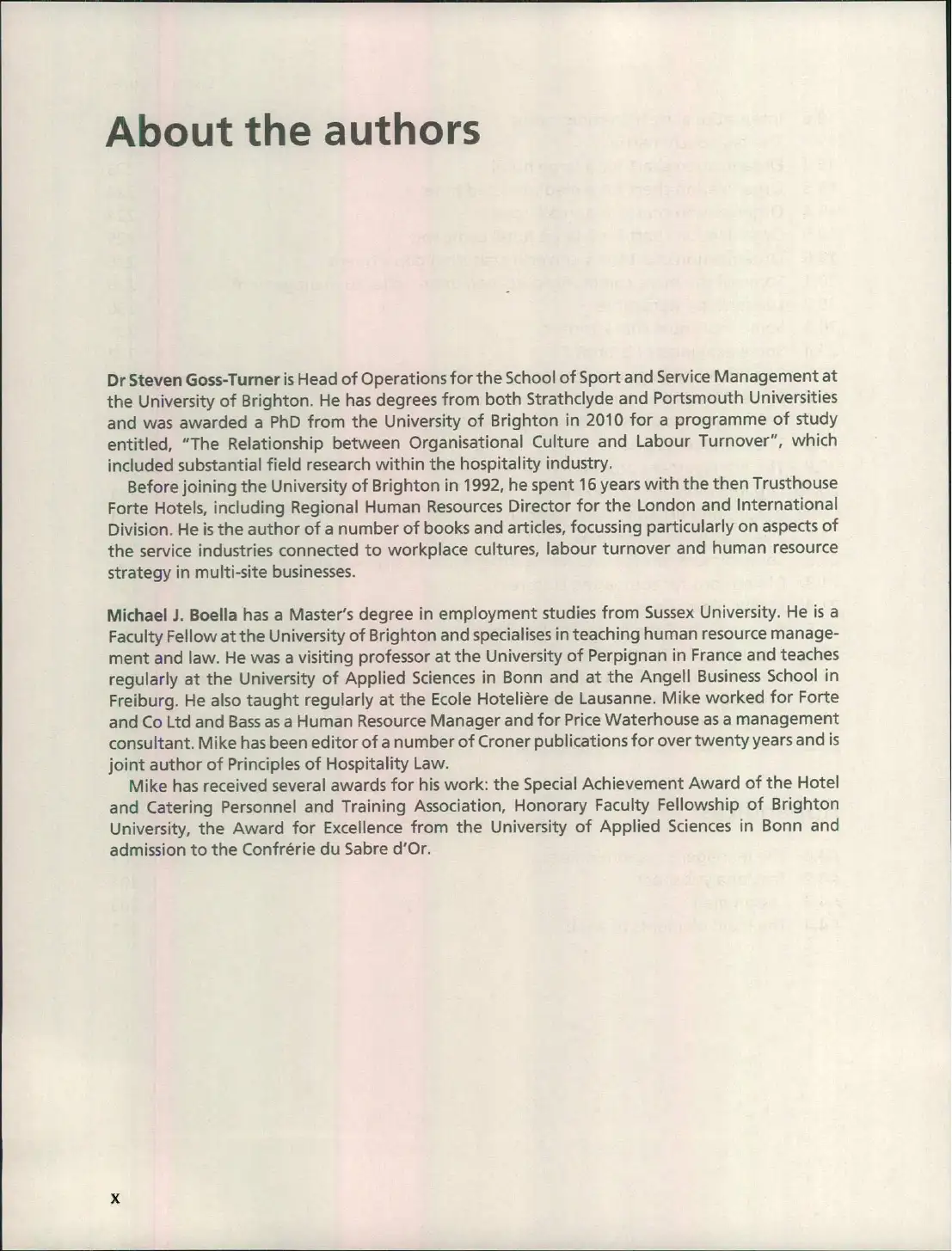
About the authors
Dr Steven Goss-Turner is Head of Operations for the School of Sport and Service Management at
the University of Brighton. He has degrees from both Strathclyde and Portsmouth Universities
and was awarded a PhD from the University of Brighton in 2010 for a programme of study
entitled, "The Relationship between Organisational Culture and Labour Turnover", which
included substantial field research within the hospitality industry.
Before joining the University of Brighton in 1992, he spent 16 years with the then Trusthouse
Forte Hotels, including Regional Human Resources Director for the London and International
Division. He is the author of a number of books and articles, focussing particularly on aspects of
the service industries connected to workplace cultures, labour turnover and human resource
strategy in multi-site businesses.
Michael J. Boella has a Master's degree in employment studies from Sussex University. He is a
Faculty Fellow at the University of Brighton and specialises in teaching human resource manage-
ment and law. He was a visiting professor at the University of Perpignan in France and teaches
regularly at the University of Applied Sciences in Bonn and at the Angell Business School in
Freiburg. He also taught regularly at the Ecole Hoteliere de Lausanne. Mike worked for Forte
and Co Ltd and Bassas a Human Resource Manager and for Price Waterhouse as a management
consultant. Mike has been editor of a number of Croner publications for over twenty years and is
joint author of Principles of Hospitality Law.
Mike has received several awards for his work: the Special Achievement Award of the Hotel
and Catering Personnel and Training Association, Honorary Faculty Fellowship of Brighton
University, the Award for Excellence from the University of Applied Sciences in Bonn and
admission to the Confrerie du Sabre d'Or.
x
Dr Steven Goss-Turner is Head of Operations for the School of Sport and Service Management at
the University of Brighton. He has degrees from both Strathclyde and Portsmouth Universities
and was awarded a PhD from the University of Brighton in 2010 for a programme of study
entitled, "The Relationship between Organisational Culture and Labour Turnover", which
included substantial field research within the hospitality industry.
Before joining the University of Brighton in 1992, he spent 16 years with the then Trusthouse
Forte Hotels, including Regional Human Resources Director for the London and International
Division. He is the author of a number of books and articles, focussing particularly on aspects of
the service industries connected to workplace cultures, labour turnover and human resource
strategy in multi-site businesses.
Michael J. Boella has a Master's degree in employment studies from Sussex University. He is a
Faculty Fellow at the University of Brighton and specialises in teaching human resource manage-
ment and law. He was a visiting professor at the University of Perpignan in France and teaches
regularly at the University of Applied Sciences in Bonn and at the Angell Business School in
Freiburg. He also taught regularly at the Ecole Hoteliere de Lausanne. Mike worked for Forte
and Co Ltd and Bassas a Human Resource Manager and for Price Waterhouse as a management
consultant. Mike has been editor of a number of Croner publications for over twenty years and is
joint author of Principles of Hospitality Law.
Mike has received several awards for his work: the Special Achievement Award of the Hotel
and Catering Personnel and Training Association, Honorary Faculty Fellowship of Brighton
University, the Award for Excellence from the University of Applied Sciences in Bonn and
admission to the Confrerie du Sabre d'Or.
x
⊘ This is a preview!⊘
Do you want full access?
Subscribe today to unlock all pages.

Trusted by 1+ million students worldwide
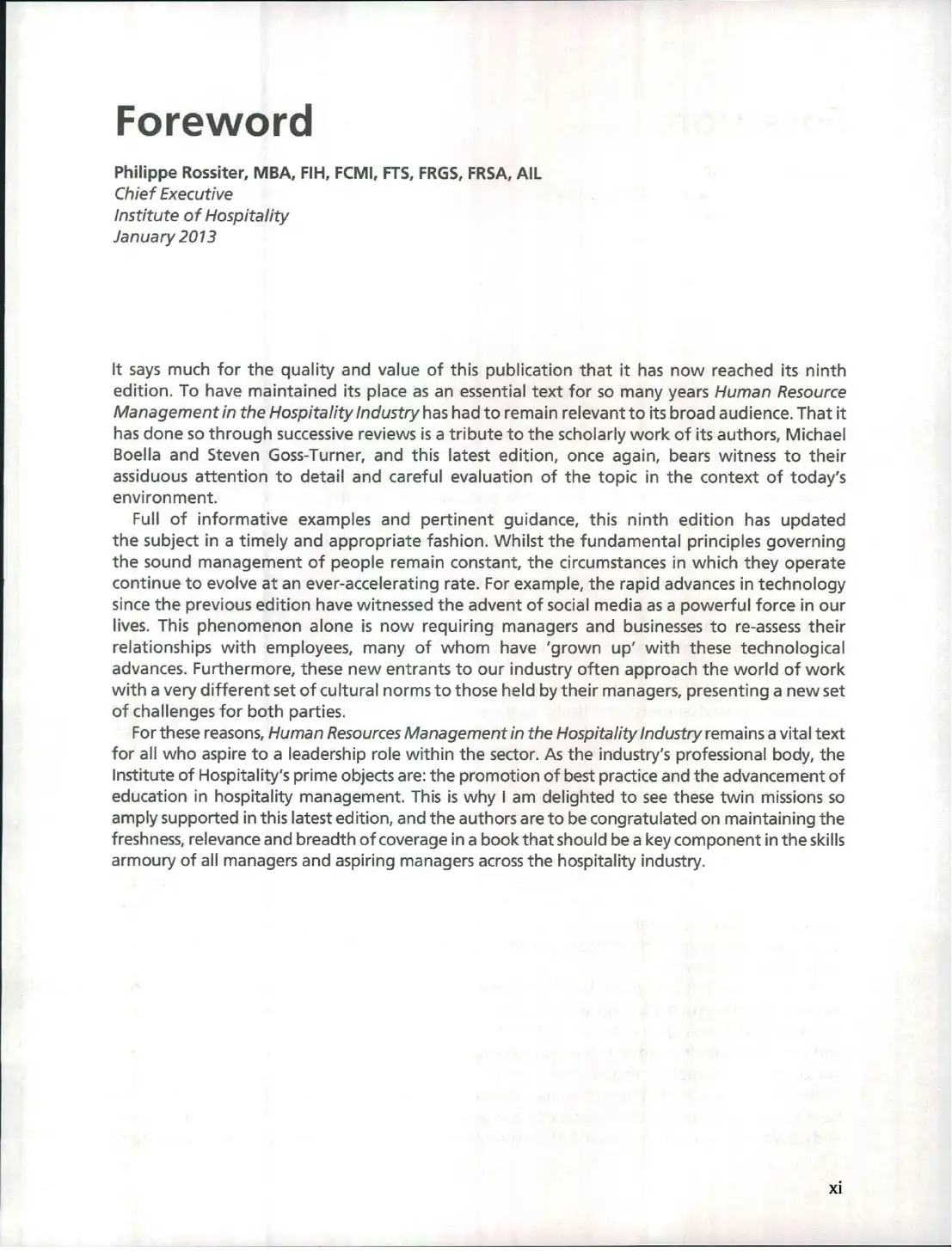
Foreword
Philippe Rossiter. MBA. FIH.FCMI.FTS,FRGS.FRSA.AIL
Chief Executive
Institute of Hospitality
January 2013
It says much for the quality and value of this publication that it has now reached its ninth
edition. To have maintained its place as an essential text for so many years Human Resource
Management in the Hospitality Industry has had to remain relevant to its broad audience. That it
has done so through successive reviews is a tribute to the scholarly work of its authors, Michael
Boella and Steven Goss-Turner, and this latest edition, once again, bears witness to their
assiduous attention to detail and careful evaluation of the topic in the context of today's
environment.
Full of informative examples and pertinent guidance. this ninth edition has updated
the subject in a timely and appropriate fashion. Whilst the fundamental principles governing
the sound management of people remain constant. the circumstances in which they operate
continue to evolve at an ever-accelerating rate. For example. the rapid advances in technology
since the previous edition have witnessed the advent of social media as a powerful force in our
lives. This phenomenon alone is now requiring managers and businesses to re-assess their
relationships with employees, many of whom have 'grown up' with these technological
advances. Furthermore, these new entrants to our industry often approach the world of work
with a very different set of cultural norms to those held by their managers. presenting a new set
of challenges for both parties.
For these reasons, Human ResourcesManagement in the Hospitality Industry remains a vital text
for all who aspire to a leadership role within the sector. As the industry's professional body, the
Institute of Hospitality's prime objects are: the promotion of best practice and the advancement of
education in hospitality management. This is why I am delighted to see these twin missions so
amply supported in this latest edition, and the authors are to be congratulated on maintaining the
freshness, relevance and breadth of coverage in a book that should be a key component in the skills
armoury of all managers and aspiring managers across the hospitality industry.
xi
Philippe Rossiter. MBA. FIH.FCMI.FTS,FRGS.FRSA.AIL
Chief Executive
Institute of Hospitality
January 2013
It says much for the quality and value of this publication that it has now reached its ninth
edition. To have maintained its place as an essential text for so many years Human Resource
Management in the Hospitality Industry has had to remain relevant to its broad audience. That it
has done so through successive reviews is a tribute to the scholarly work of its authors, Michael
Boella and Steven Goss-Turner, and this latest edition, once again, bears witness to their
assiduous attention to detail and careful evaluation of the topic in the context of today's
environment.
Full of informative examples and pertinent guidance. this ninth edition has updated
the subject in a timely and appropriate fashion. Whilst the fundamental principles governing
the sound management of people remain constant. the circumstances in which they operate
continue to evolve at an ever-accelerating rate. For example. the rapid advances in technology
since the previous edition have witnessed the advent of social media as a powerful force in our
lives. This phenomenon alone is now requiring managers and businesses to re-assess their
relationships with employees, many of whom have 'grown up' with these technological
advances. Furthermore, these new entrants to our industry often approach the world of work
with a very different set of cultural norms to those held by their managers. presenting a new set
of challenges for both parties.
For these reasons, Human ResourcesManagement in the Hospitality Industry remains a vital text
for all who aspire to a leadership role within the sector. As the industry's professional body, the
Institute of Hospitality's prime objects are: the promotion of best practice and the advancement of
education in hospitality management. This is why I am delighted to see these twin missions so
amply supported in this latest edition, and the authors are to be congratulated on maintaining the
freshness, relevance and breadth of coverage in a book that should be a key component in the skills
armoury of all managers and aspiring managers across the hospitality industry.
xi
Paraphrase This Document
Need a fresh take? Get an instant paraphrase of this document with our AI Paraphraser
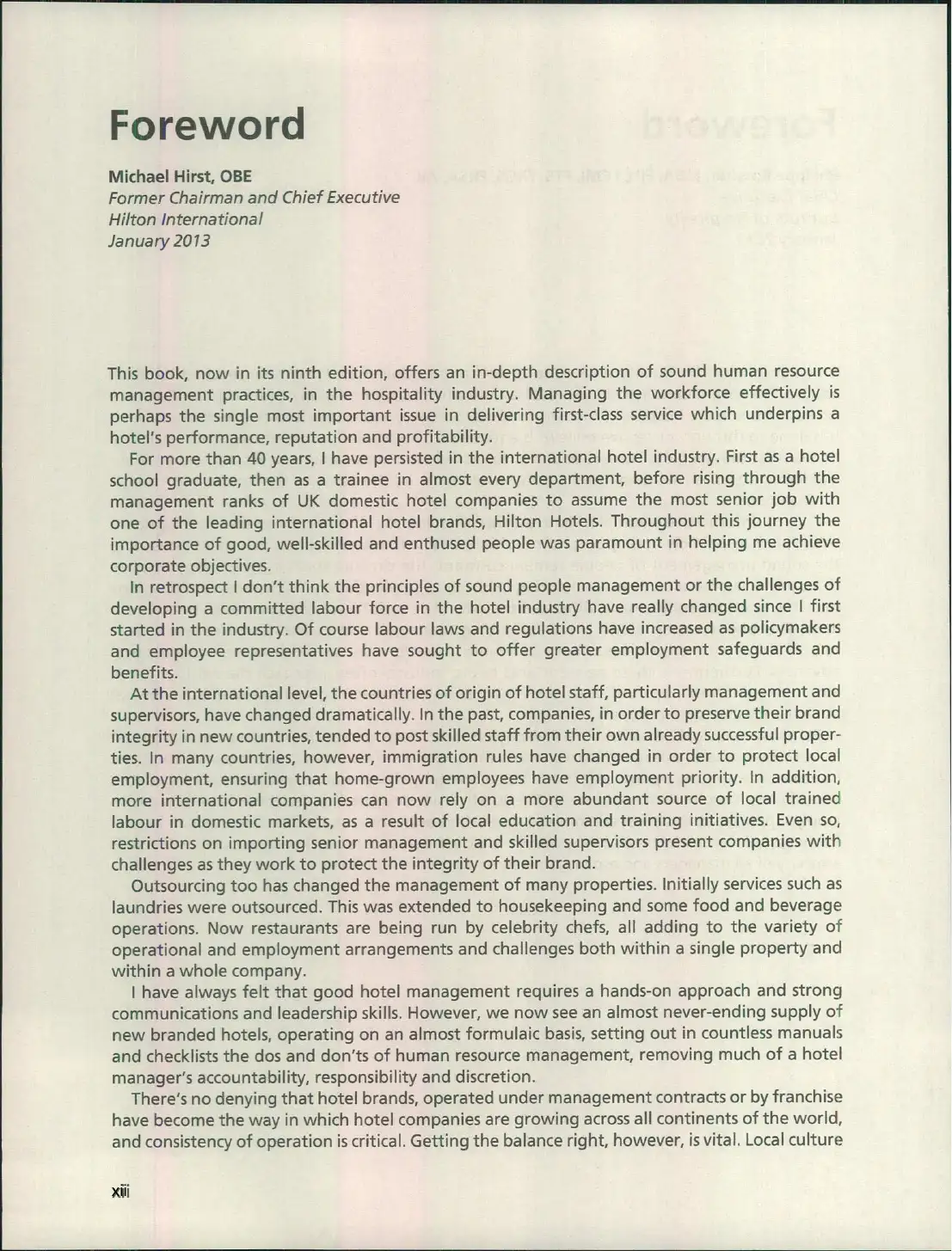
Foreword
Michael Hirst, aBE
Former Chairman and Chief Executive
Hilton International
January 2013
This book, now in its ninth edition, offers an in-depth description of sound human resource
management practices, in the hospitality industry. Managing the workforce effectively is
perhaps the single most important issue in delivering first-class service which underpins a
hotel's performance, reputation and profitability.
For more than 40 years, I have persisted in the international hotel industry. First as a hotel
school graduate, then as a trainee in almost every department, before rising through the
management ranks of UK domestic hotel companies to assume the most senior job with
one of the leading international hotel brands, Hilton Hotels. Throughout this journey the
importance of good, well-skilled and enthused people was paramount in helping me achieve
corporate objectives.
In retrospect I don't think the principles of sound people management or the challenges of
developing a committed labour force in the hotel industry have really changed since I first
started in the industry. Of course labour laws and regulations have increased as policymakers
and employee representatives have sought to offer greater employment safeguards and
benefits.
At the international level, the countries of origin of hotel staff, particularly management and
supervisors, have changed dramatically. In the past, companies, in order to preserve their brand
integrity in new countries, tended to post skilled staff from their own already successfulproper-
ties. In many countries, however, immigration rules have changed in order to protect local
employment, ensuring that home-grown employees have employment priority. In addition,
more international companies can now rely on a more abundant source of local trained
labour in domestic markets, as a result of local education and training initiatives. Even so,
restrictions on importing senior management and skilled supervisors present companies with
challenges asthey work to protect the integrity of their brand.
Outsourcing too has changed the management of many properties. Initially servicessuch as
laundries were outsourced. This was extended to housekeeping and some food and beverage
operations. Now restaurants are being run by celebrity chefs, all adding to the variety of
operational and employment arrangements and challenges both within a single property and
within a whole company.
I have always felt that good hotel management requires a hands-on approach and strong
communications and leadership skills. However, we now see an almost never-ending supply of
new branded hotels, operating on an almost formulaic basis, setting out in countless manuals
and checklists the dos and don'ts of human resource management, removing much of a hotel
manager's accountability, responsibility and discretion.
There's no denying that hotel brands, operated under management contracts or by franchise
have become the way in which hotel companies are growing acrossall continents of the world,
and consistency of operation is critical. Getting the balance right, however, is vital. Local culture
xii
Michael Hirst, aBE
Former Chairman and Chief Executive
Hilton International
January 2013
This book, now in its ninth edition, offers an in-depth description of sound human resource
management practices, in the hospitality industry. Managing the workforce effectively is
perhaps the single most important issue in delivering first-class service which underpins a
hotel's performance, reputation and profitability.
For more than 40 years, I have persisted in the international hotel industry. First as a hotel
school graduate, then as a trainee in almost every department, before rising through the
management ranks of UK domestic hotel companies to assume the most senior job with
one of the leading international hotel brands, Hilton Hotels. Throughout this journey the
importance of good, well-skilled and enthused people was paramount in helping me achieve
corporate objectives.
In retrospect I don't think the principles of sound people management or the challenges of
developing a committed labour force in the hotel industry have really changed since I first
started in the industry. Of course labour laws and regulations have increased as policymakers
and employee representatives have sought to offer greater employment safeguards and
benefits.
At the international level, the countries of origin of hotel staff, particularly management and
supervisors, have changed dramatically. In the past, companies, in order to preserve their brand
integrity in new countries, tended to post skilled staff from their own already successfulproper-
ties. In many countries, however, immigration rules have changed in order to protect local
employment, ensuring that home-grown employees have employment priority. In addition,
more international companies can now rely on a more abundant source of local trained
labour in domestic markets, as a result of local education and training initiatives. Even so,
restrictions on importing senior management and skilled supervisors present companies with
challenges asthey work to protect the integrity of their brand.
Outsourcing too has changed the management of many properties. Initially servicessuch as
laundries were outsourced. This was extended to housekeeping and some food and beverage
operations. Now restaurants are being run by celebrity chefs, all adding to the variety of
operational and employment arrangements and challenges both within a single property and
within a whole company.
I have always felt that good hotel management requires a hands-on approach and strong
communications and leadership skills. However, we now see an almost never-ending supply of
new branded hotels, operating on an almost formulaic basis, setting out in countless manuals
and checklists the dos and don'ts of human resource management, removing much of a hotel
manager's accountability, responsibility and discretion.
There's no denying that hotel brands, operated under management contracts or by franchise
have become the way in which hotel companies are growing acrossall continents of the world,
and consistency of operation is critical. Getting the balance right, however, is vital. Local culture
xii
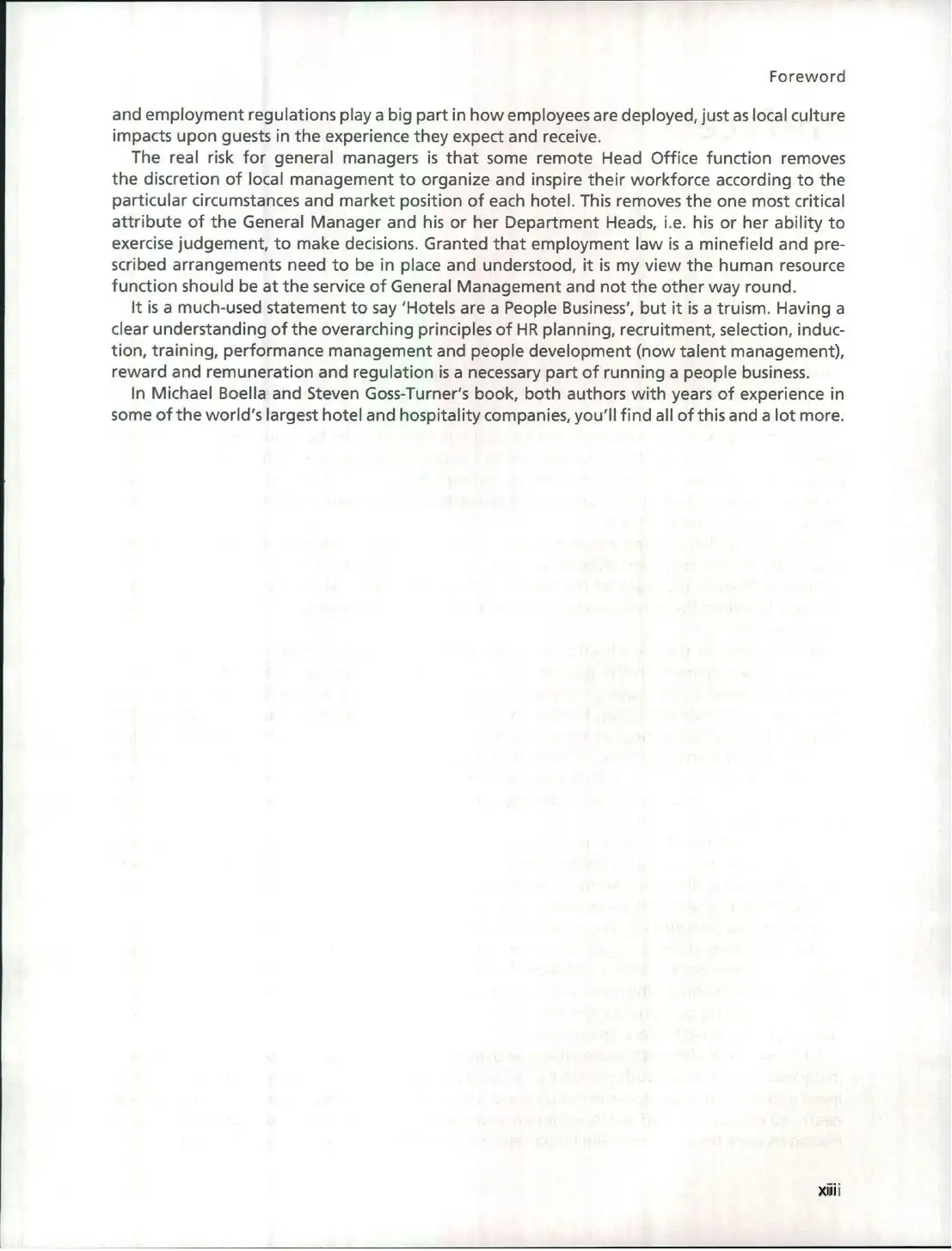
Foreword
and employment regulations playa big part in how employees are deployed, just as local culture
impacts upon guests in the experience they expect and receive.
The real risk for general managers is that some remote Head Office function removes
the discretion of local management to organize and inspire their workforce according to the
particular circumstances and market position of each hotel. This removes the one most critical
attribute of the General Manager and his or her Department Heads, i.e. his or her ability to
exercise judgement, to make decisions. Granted that employment law is a minefield and pre-
scribed arrangements need to be in place and understood, it is my view the human resource
function should be at the service of General Management and not the other way round.
It is a much-used statement to say 'Hotels are a People Business', but it is a truism. Having a
clear understanding of the overarching principles of HR planning, recruitment, selection, induc-
tion, training, performance management and people development (now talent management),
reward and remuneration and regulation is a necessary part of running a people business.
In Michael Boella and Steven Goss-Turner's book, both authors with years of experience in
some of the world's largest hotel and hospitality companies, you'll find all ofthis and a lot more.
xiii
and employment regulations playa big part in how employees are deployed, just as local culture
impacts upon guests in the experience they expect and receive.
The real risk for general managers is that some remote Head Office function removes
the discretion of local management to organize and inspire their workforce according to the
particular circumstances and market position of each hotel. This removes the one most critical
attribute of the General Manager and his or her Department Heads, i.e. his or her ability to
exercise judgement, to make decisions. Granted that employment law is a minefield and pre-
scribed arrangements need to be in place and understood, it is my view the human resource
function should be at the service of General Management and not the other way round.
It is a much-used statement to say 'Hotels are a People Business', but it is a truism. Having a
clear understanding of the overarching principles of HR planning, recruitment, selection, induc-
tion, training, performance management and people development (now talent management),
reward and remuneration and regulation is a necessary part of running a people business.
In Michael Boella and Steven Goss-Turner's book, both authors with years of experience in
some of the world's largest hotel and hospitality companies, you'll find all ofthis and a lot more.
xiii
⊘ This is a preview!⊘
Do you want full access?
Subscribe today to unlock all pages.

Trusted by 1+ million students worldwide
1 out of 14
Your All-in-One AI-Powered Toolkit for Academic Success.
+13062052269
info@desklib.com
Available 24*7 on WhatsApp / Email
![[object Object]](/_next/static/media/star-bottom.7253800d.svg)
Unlock your academic potential
Copyright © 2020–2025 A2Z Services. All Rights Reserved. Developed and managed by ZUCOL.

